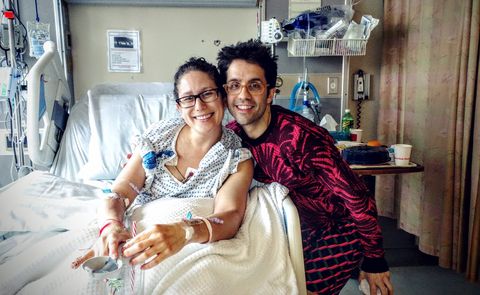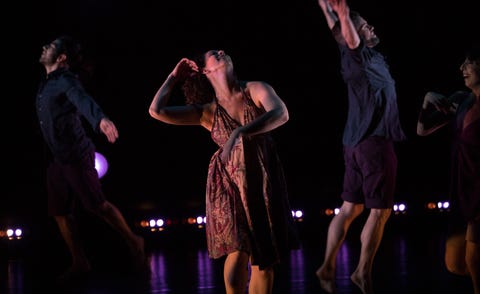When Ashley Newman woke up on May 5, 2016, she went about her day like any other. She had a work meeting, went to a doctor’s appointment, and took a bridesmaid’s dress in for alterations—all in the midst of the hustle and bustle of New York City.
Newman, who has been a dancer her entire life, was rehearsing for a show for The Chase Brock Experience later that night, a dance company she had been with for years. The 32-year-old had spent the last few years teaching, and was excited for the chance to perform again. “I was totally fine, I was dancing, I was feeling good,” she recalls.
And then, everything gets a bit fuzzy. Once the rehearsal was over, Newman and her fellow dancers viewed a few versions of the routine on her laptop. The last thing she remembers is stowing it away in her bag—right before she went into sudden cardiac arrest, a condition in which your heart’s electrical system goes haywire and the heart abruptly stops beating.
While she doesn’t remember it herself, Newman was suddenly leaning against the wall, dropping to the floor. The eight dancers in the room with her—one a former student, some who had been at her wedding—noticed her slipping. Terrified when they realized she wasn’t breathing properly or responding, they called 911. She started turning blue and her pulse faded. In that moment, they knew they had to do CPR immediately.
They weren’t trained in CPR, but the dispatcher talked them through it, telling them to push down hard and fast, counting the chest compressions aloud as they tried to save their friend. Minutes later, emergency services arrived. Newman was shocked once with a defibrillator, and her pulse came back.
“They were terrified, but they listened to directions, and they kept doing what they were supposed to do, which is why I’m here,” she says.
Newman wouldn’t piece these moments together until the next day, where she finally woke up in a hospital room with a breathing tube down her throat. Coming out of the fog, she opened her eyes and saw some of the dancers, her husband, his parents, and her mother, who lives in Florida, standing there with a suitcase. That’s when she realized something terrible had happened to her.
CPR played a critical role
If Newman’s friends had not administered CPR, her outlook would have been grim. Only 46 percent of cardiac arrest victims get the help they need before EMS arrives, and 92 percent will die before making it the hospital.
Learning CPR is easier than you’d guess. Experts no longer recommend mouth-to-mouth, and instead adhere to this three-step process:
Life after cardiac arrest
To this day, Newman’s doctors aren’t entirely sure why her heart malfunctioned. “Because I was not wearing a heart monitor at the time of the sudden cardiac arrest, no one can ever know exactly why this happened or what triggered it,” says Newman. She was, however, diagnosed with catecholaminergic polymorphic ventricular tachycardia (CPVT), meaning her heart rate increases or becomes irregular in response to exercise.

“I can’t feel it, and after rehearsal on May 5th I also didn’t feel my heart rate increasing abnormally more than it would any of the other thousands of times I have danced,” she explains. This was bizarre, because her entire career was marked by countless grueling rehearsals, classes, and shows.
A majority of people who do experience cardiac arrest do not survive before making it to the hospital. Of those who do, many suffer from brain damage, trouble walking, and other serious complications.
Newman has made a remarkable recovery, though. While she did have a permanent defibrillator installed below her left arm, a device that was sewn into her muscle to track her heart rate, Newman has dealt with hardly any health issues following her incident. That’s why she still has a hard time believing it even happened. She was only in her early 30s at the time and never felt any symptoms.
“For me to have no warning signs—that’s something I struggle with,” she explains. “How did I not know? How did I not feel it?”
“After all of this, I honor my body in a different way than I did before.”
The worst part? She wasn’t sure if she would ever dance again. But only a year after her cardiac arrest, Newman hit the stage. The Chase Brock Experience was celebrating its tenth year, so naturally, they put on a big show. Slightly nervous at first, she danced her way through 12 performances—right alongside the people that saved her life. Even a couple of her EMS first responders showed up in the audience to support her.
“Getting to perform in that show, I had so much fun,” she says, getting slightly emotional. “I really tried to live in the moment. Dancing, and being able to move my body in space, in a way that feels good to me, I don’t take that for granted anymore. I feel like I was more present and having the best time—more than any other time I danced. I think this whole experience gave me that gift, in a way.”

While she feels like relatively the same person, Newman’s outlook on life has understandably shifted. “Especially when I think about how rare it is to survive something like this, I definitely pause in my day,” she says.
And even though she had no warning signs prior to her cardiac arrest, she believes staying in tune with her system through exercises like yoga is now more important than ever.
“After all of this, I honor my body in a different way than I did before. As a dancer, I always did—but I also kind of abused it,” says Newman. “Dancers use their bodies, we push ourselves really hard and I think there’s a new lesson for me in really paying attention to what I’m feeling and noticing—and if something’s not quite right, to really note it.”
From: Prevention US
Source: Read Full Article
